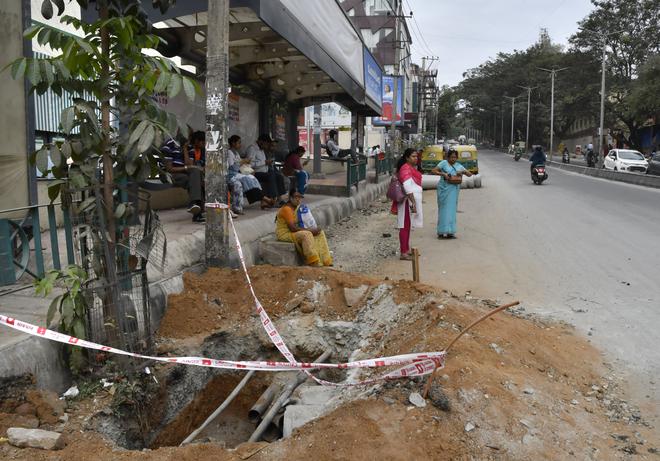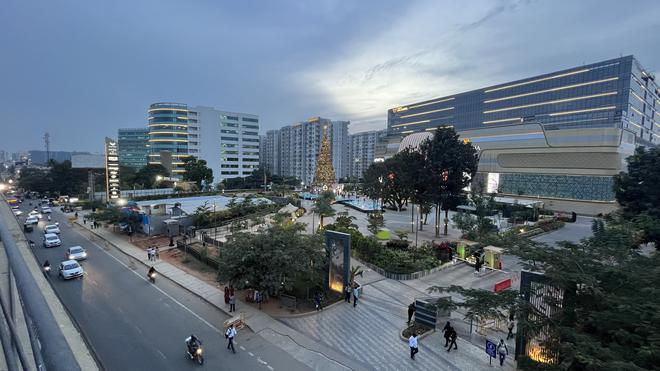In the week leading up to Christmas, a newly inaugurated mall on the service road of Ballari Road in north Bengaluru — Phoenix Mall of Asia — was constantly in the news for the massive traffic jams outside the humongous structure. But on Christmas Eve, the situation turned into a nightmare. While the mall has a parking capacity for 2,324 cars and two-wheelers, vehicles of the people who had come to the mall — an estimated four times the capacity — piled up on the road outside with nowhere to go.
Soon after, Police Commissioner B. Dayananda requested the city’s civic body, the Bruhat Bengaluru Mahanagara Palike (BBMP), to withdraw the partial occupancy certificate (OC) provided to the mall, citing a plethora of reasons, including insufficient parking facility. The BBMP said that since the building bylaws and zonal regulations were followed by the mall, the withdrawal of the OC was unlikely.
While the all-too-common traffic jams in the burgeoning IT capital have moved on from being “news” to becoming a matter of jokes and memes on social media, what the Christmas Eve chaos highlighted was the complete absence of coordination among civic agencies. “Construction of the structure was going on for years. Why didn’t the agencies concerned say anything about the insufficient parking facility until the mall was up and running?” asked Madappa K., a cab driver who has made several trips to the mall.

Same problems, different localities
Problems such as traffic congestion, lack of parking space, and entry and exit point blockades have been flagged by residents living near commercial establishments, large apartment complexes, schools, and workspaces.
For instance, the almost 2-km-long stretch between Borewell Road and the B.R. Ambedkar statue at Whitefield in east Bengaluru had 14 schools back in 2018. Today, many more apartment complexes and schools have come up on the stretch, leaving the main road unequipped to handle the traffic density.
“While giving building permissions at such places, why does the BBMP not think about parking facilities and entry and exit strategies from the buildings before vehicles coming there add to the traffic?” questioned Zibi Jamal of Whitefield Rising, a citizens’ collective.
She pointed out that several stores on the main roads at Whitefield have no parking facility despite the people coming there invariably bringing their vehicles. “There is also a famous restaurant at Kundalahalli and many fast-food joints around Whitefield which have absolutely no space for car parking. Some of them take up a lane or two on roads for parking, leading to traffic snarls,” she added. Similar complaints have been aired against restaurants in other areas of the city, but they continue to flourish, with no parking facility, adding to the traffic chaos in these localities.
The perpetual parking and traffic problems also arise out of the rapid and sometimes illegal commercialisation of spaces, even in residential areas. “Let alone inter-departmental coordination, there is no coordination between two arms of the BBMP itself,” says Nitin Seshadri, a citizen activist from the south-eastern locality of Koramangala. “One arm of the BBMP collects commercial property tax from commercialised spaces while another arm of the agency sends notices to these places for illegal commercialisation,” he says.

School buses add to mix
Another contributor to the chaos, Seshadri adds, is the Education Department. In Koramangala, with schools, especially pre-schools and primary schools, coming up adjacent to residential areas, many school buses are parked on the roads of residential localities. “When we complained to the BBMP about this, they directed us to the Education Department, saying they have nothing to do with schools. Department people told us their concern is the number of classrooms and other infrastructure in schools and not the elements of urban planning,” he says.
A senior police official pointed out that besides the lack of coordination among agencies, the problem in Bengaluru is unplanned development. He cited the Outer Ring Road (ORR), which runs along the periphery of the city and houses many tech parks, and HSR Layout, one of the posh residential localities in south-east Bengaluru, as some of the examples where unplanned development has led to traffic issues.
“On the ORR, there was unrestricted development without making enough provisions for public transport. HSR Layout was initially meant to be a residential area, but now, they are demolishing houses and constructing office buildings. In a place where 50 people were supposed to be, there are now 5,000 people working. With no adequate parking facility, vehicles of these people end up on the roads,” the police official says.
Citizens seek for more consultation
After the Police Commissioner ordered a temporary closure of Mall of Asia following the traffic chaos, the mall authorities challenged it in the High Court of Karnataka, arguing they had not violated building bylaws. On the directions of the High Court, the Bengaluru traffic police (BTP) worked out a traffic circulation plan.
“We have ensured that pick-up and drop-off by taxis as well as autorickshaws happen inside the mall premises and not outside. As a long-term measure, we are coordinating with the BBMP and the National Highways Authority of India (NHAI) and even with Bangalore Metro Rail Corporation Ltd. (BMRCL) as multiple projects will come up in that area and it will require holistic planning,” says M.N. Anucheth, Joint Commissioner of Police (Traffic), Bengaluru.
“A little planning beforehand, which could have been initiated by the traffic police themselves, would have saved a lot of time for everyone,” says Rajendra Rao, a daily commuter on Ballari Road.
Like him, many other people said it was high time the BBMP and the BTP worked in tandem. “There is no evidence that the BBMP consults the BTP when it comes to urban planning or giving permissions even though traffic is one of the key issues of urban planning,” Jamal said.
For ‘entertainment’ only
Anucheth also notes that whenever big projects which have residential, commercial, and retail spaces coming up, there would invariably be some traffic congestion, at least initially. “From our end, we are proposing that a traffic mobility plan be included as a part of the project while sanctioning the plan itself. We are recommending to the government to make it a part of the policy,” he says adding that for big projects with a certain square foot area, a traffic mobility plan is essential.
According to the bylaws, the BBMP asks for a no objection certificate (NOC) from the traffic police only if the building runs trade categorised as “entertainment”. “The bylaws are outdated. The rationale seems to be that only the kind of trade, for instance, a movie theatre, will attract large crowds and hence such buildings need an NOC from the traffic police. This seems to pre-date the concept of modern malls. The nature of public spaces has changed so much now. The rationale for the inclusion of traffic police at the planning stage should be the estimated footfall of the proposed building. The built-up area can be a good indicator of that,” Anucheth explains.
After the recent events, the BBMP too has decided to include a traffic mobility plan in building bylaws. “We had a provision of looking into the mobility plan until 2011. After that, since it was not officially made part of the building bylaws, it could not be pursued. Now, we must bring in an amendment to our building bylaws to say there must be a mobility plan for any commercial or industrial establishment above a certain square feet area. We have to take this forward through a committee of experts and get the approval,” Tushar Giri Nath, Chief Civic Commissioner, BBMP, told The Hindu.
Civic coordination necessary
The lack of coordination between the BBMP, the Bangalore Water Supply and Sewerage Board (BWSSB), and the Bangalore Electricity Supply Company (Bescom) has been reflected in many forms in the city, mainly through infrastructural inconvenience.
Indiranagar in east Bengaluru is one of the areas in the city where such problems have persisted for years now. “Infrastructure projects have been going on in Indiranagar for a while now,” says Anoop Hegde from I Change Indiranagar, a local collective. “When the CMH Road was being white-topped, we had assumed that different agencies had coordinated with each other because there were a lot of pipes and cables running below the roads. But we realised that while the BBMP laid ducts for underground cables, Bescom did not have the budget to lay new cables there.”
When the busy 100-ft. road was being white-topped, the project was delayed as the BBMP had not coordinated with the BTP, he says. “The BWSSB is digging up roads and pavements after the entire project was completed,” he says, highlighting the horrors that absence of coordination has led to.
Citizens also say that civic coordination also plays a vital role in stopping the illegal commercialisation of many places. “The BBMP should take an NOC from all civic entities before giving licences to commercial establishments. Even if regulations of one civic agency are violated, then no agency should give approval for the project,” says Seshadri.







